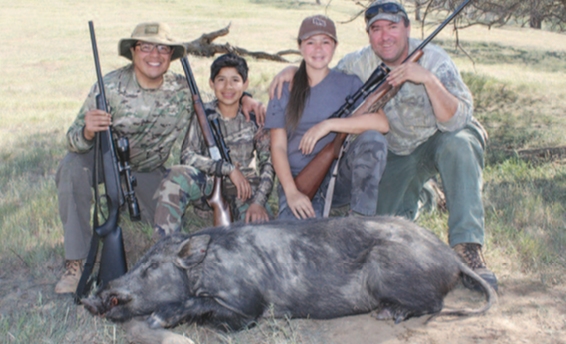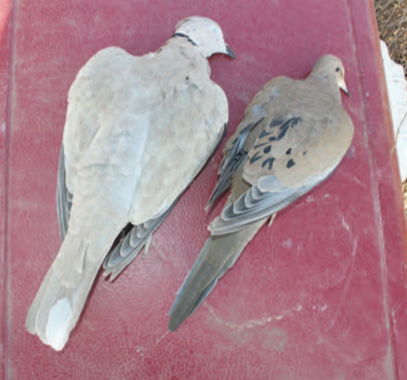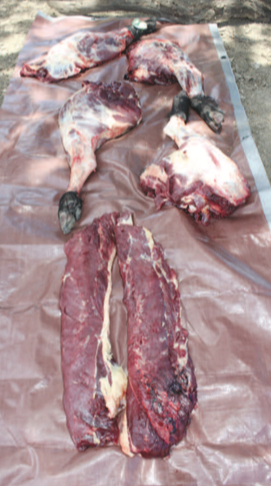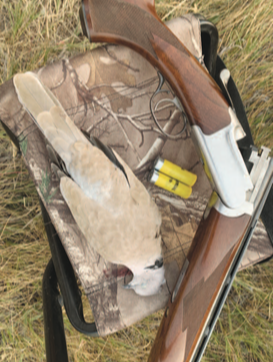
BY TIM E. HOVEY
A few weeks back I wrote an article on varmint hunting and how a few species have a non-game designation here in California which allow for year-round pursuit. Animals like coyotes and ground squirrels are native to the state and have no season or limit and can help hunters sharpen their shooting skills in the off season.
Another group of animals that can also be chased year-round are relatively new arrivals to California and are not considered native. In the terms of management, they are referred to as non-native or exotic species. For the purpose of this piece, exotics animals will refer to animals that were unintentionally introduced into the state and now pose a detriment to either native species or crops.
Currently, there are three huntable, non-native species here in the state: wild pig, Eurasian dove and the Starling. These animals are not native to California and did not evolve around the other native species in the Golden State. This puts them at odds with our native wildlife, and from an ecosystem standpoint, they are pests.

While other species have invaded California over the years, these three species have drawn the attention of sportsmen for somewhat obvious reasons. The wild pig is a challenging big game animal to hunt, available in 56 of the 58 counties in California and excellent on the plate. The Eurasian dove started showing up in the early 2000s and has become a favorite for wing shooters both during and after the local dove season. The Starling has pretty much been designated a pest since it’s arrival in California in the 1950s and it seriously seems like an unstoppable invasion.
The history of these three species, and a how they came to permanently reside in California is very different. The current strain of wild pig is a cross between domesticated pigs that escaped from Spanish and Russian settlers in the 1700s and became feral, and introduced wild boars released by a landowner in Monterey County in the 1920s. This feral/wild cross is a sturdy, hard to kill, big game animal that will test the skills of any hunter.
The Eurasian dove was accidently released in the Bahamas in the 1970s. They were first reported in the States in the 1990s, with sightings starting in Florida. It took a short twenty years for them to make it across the country to California, with reports starting in the Imperial Valley in the early 2000s. Despite this clearly being an exotic species, it took California Fish and Wildlife until 2014 to open them up statewide to hunting. About 50% larger than the mourning dove, Eurasians are challenging to hit in flight and taste just like their smaller native cousin.
The starling owes its nationwide spread to some odd group in New York that decided they wanted to release every bird mentioned in the works of Shakespeare into the country. In the 1890s, one hundred starlings were released into Central Park and from there the infestation spread. The latest tally from the U.S. Department of Agriculture places the nationwide count at over 200 million birds, with no control in sight.
The wild boar and the Eurasian dove have firmly established themselves as huntable species and are frequently taken by hunters. Both are good on the plate, and despite their exotic status, both species appear to have a solid hunter following.
Unfortunately, the starling does not share this notoriety. The sheer numbers of this invader, and their propensity to gather in groups numbering in the thousands, makes them a menace. They easily outcompete native songbirds, frequently pushing them from their habitat. Forming enormous flocks, these birds have been responsible for several deadly aviation bird strikes on planes. They are also a serious agricultural pest, causing a total of $800 million in damage through crop consumption and excess droppings nationwide.
Due to their destructive nature, many in the air gun hunting industry have targeted this species as an easy-to-find bird to pursue. It doesn’t matter if you can’t identify this species from any other bird, I guarantee you’ve seen them before.
Both the wild pig and Eurasian dove also have a measurable impact on California’s habitat, crops or native species. A small group of wild pigs can destroy acres of native habitat in an evening or decimate agricultural crops as well. The swift invasion of the Eurasian dove is still in its relative infancy, but the fact that it inhabits the same habitat as the mourning dove, causes concerns for biologist suggesting that this huntable invader may be impacting our native dove through increased competition. Only time will tell.

As a hunter, it’s good to see additional animals to pursue, even during the off season. Just like any huntable species, the California Department of Fish and Wildlife requires a hunting license to hunt anything in the state. They also require a pig tag for every pig taken.
You may ask yourself why would you need a tag to hunt an exotic species? That’s a very good question. Having hunted wild pig for almost thirty years, I can boil it down to one word: revenue. When I first started chasing pigs, you could purchase a book of five tags for around $7.00. The resident price for a pig tag is now $25.92 for a single tag. If you’re a non-resident, you’ll pay over triple that cost.
Despite the wild pig being an introduced species, the State sees fit to charge hunters for the right to chase them. The price of the tags has steadily gone up each year, with no adjustments to pig management. Makes me wonder where all that money is going and why the tag fees continue to increase year after year.
These three species certainly allow for year-round hunting opportunities for the California sportsman. Their invasive status means that they can be found just about anywhere their preferred habitat exists. I’ve had the opportunity to hunt each of these species, and the hunter in me is grateful for the opportunity. However, the biologist in me does wonder what the longer-term impacts of these exotic species will be on native species and habitat. Either way, hunters can at least feel like they’re doing their part to slow down the invasion.




